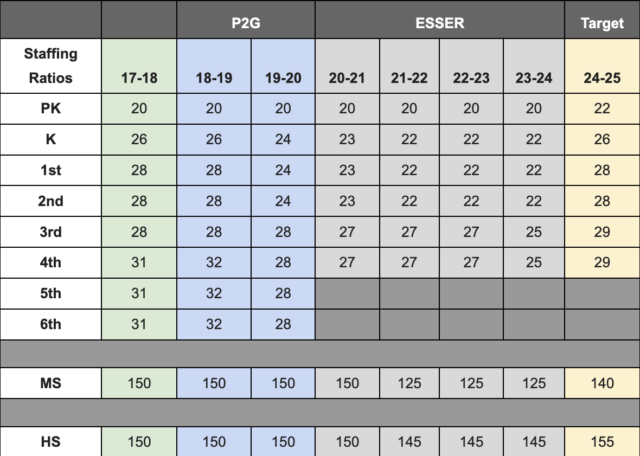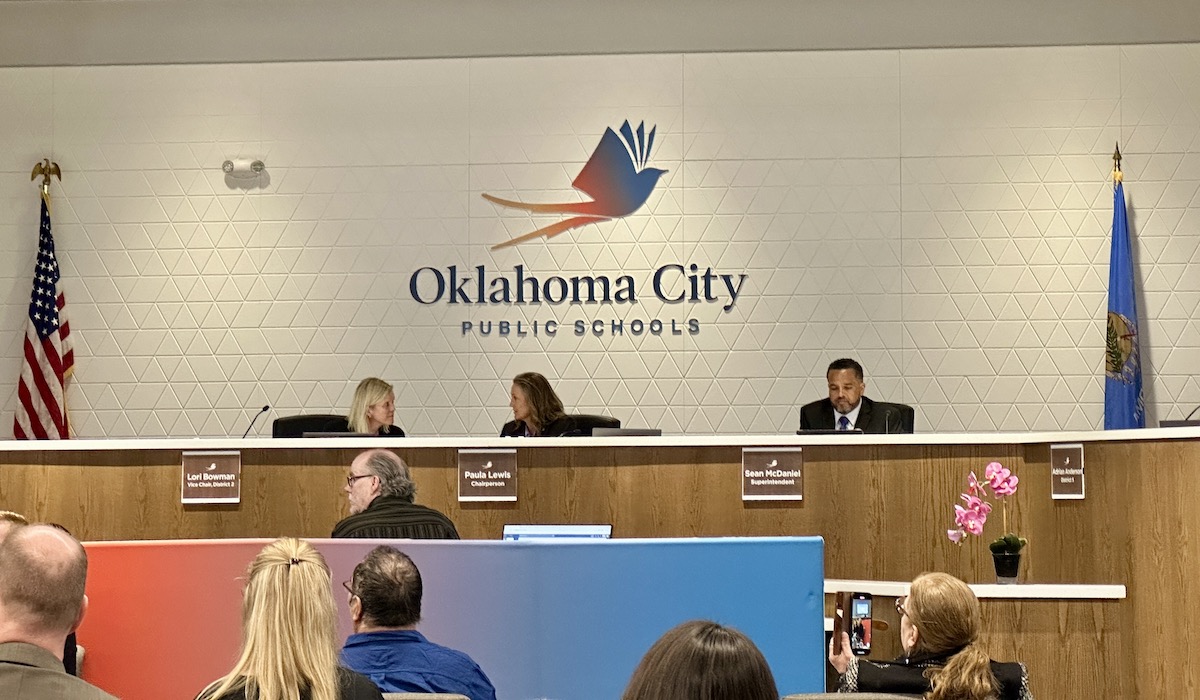

Class sizes for Oklahoma City Public Schools are set to increase next school year as the district spends the last of its pandemic-era stimulus money. While the development has been anticipated for years, it has added stress at district sites where an unknown number of teachers are being notified their positions will not be renewed for the 2024-2025 school year.
“I don’t necessarily have the numbers off the top of my head, but the important thing to remember is that every year we go through some contract non-renewals with non-continuing contract teachers,” OKCPS deputy superintendent Jason Brown said Monday night.
Discussed at the OKCPS board’s March 11 meeting and again mentioned during Monday night’s meeting, the end of federal Elementary and Secondary School Emergency Relief Fund support will mean fewer educators in district schools next fall.
“We had different strategies that we were using with the ESSER funds. One of the strategies (was) to address what we at the time called unfinished learning — we knew that there was this kind of learning gap that had occurred because of COVID,” deputy superintendent Jason Brown told NonDoc on Monday. “One of the strategies that we invested quite a bit of money on is we thought, during this pandemic, if we can get class sizes down as low as possible (…) teachers would have a better opportunity to connect more intimately with each individual student.”
Provided by the federal government in three tranches starting in 2020, the ESSER funding was meant to help school districts across the country as students stayed home during shelter-in-place periods and virtual schooling. Program stipulations require districts to encumber all ESSER funds by Sept. 30 or pay the money back. OKCPS has pledged to encumber all of the funds by June 30, the end of Oklahoma’s fiscal year.
When that happens, Brown explained that the smaller class sizes OKCPS has enjoyed over the last few years will go back to 2018 and 2019 levels.
“That’s the plan that our CFO is working on,” Brown told the board March 11. “How do we — without those federal stimulus dollars — continue to get the good results that we got by some of the investments that we made. In some cases, it’s a transfer of funds. In some cases, it’s making some tough decisions.”
During his March 11 presentation, Brown said one of those “tough decisions” involved phasing out “premium staffing” allowed by the additional money.
“We’ve been preparing — and our principals have been preparing — knowing that those ratios would increase year after year — getting us back to normal staffing ratios, and so next year we’ll be back to normal, non-ESSER-inflated staffing ratios,” Brown said. “So there will be a difference when you walk into a classroom. It’ll take us back to pre-pandemic numbers, which are normal in a sense, but if you’ve been a principal or a teacher in the last four years, then those numbers are higher — a lot higher — than what you’re used to seeing.”
After Monday night’s marathon board meeting that saw a decision bond project spending and new limitations on how outgoing Superintendent Sean McDaniel can spend money or making hiring decisions, Chairwoman Paula Lewis said the district has been prepared for the looming class size increase.
“Our priority is finding a superintendent right now,” Lewis said. “We knew ESSER (funding) was temporary.”
‘A whiplash to go back to larger numbers’

OKCPS director of communications Crystal Raymond said no teachers were paid with ESSER funds. Brown told NonDoc on Monday evening class sizes could increase because of non-renewal of adjunct teacher contracts and other, non-tenured or less qualified teachers.
“What our goal is, and hope is, is that as we’re not renewing employment with some, it is those teachers that we really had to get qualified through adjunct or emergency that we won’t necessarily be continuing with, in some cases,” Brown said. “Now, some worked out really well, and honestly, we’re still going to need emergency-certified teachers, and probably still a few adjuncts. Hopefully, we’ll need fewer of those.”
Brown said he thought teachers and students noticed a significant difference in learning during the period of lower class sizes, but he said the district had been preparing for a return to pre-pandemic staffing levels since last year.
“Knowing that it was going to feel like somewhat of a whiplash to go back to larger numbers, last year, we kind of incrementally raised [class sizes],” Brown said. “This year, when we [announced] staffing numbers that were equivalent of what we did prior to the COVID — I mean, we’re talking about three, four years of really good numbers — it felt like whiplash to people.”
To that end, an OKCPS chart showing the district’s average class sizes for the last seven school years and projected averages for next year depicts across-the-board class size increases.
Pre-K class sizes are projected to increase from 20 to 22 students for the first time since 2016. Kindergarten classes are projected to increase from 22 students to 26. Similarly, first and second grade classes are expected to increase from 22 to 28 students, and third and fourth grade classes are expected to increase from 25 to 29 students.
Middle school teachers who handle multiple sections in the same subject areas are projected to take on 15 more students, from 125 to 140. High school teachers are projected to take on 155 students, an increase of 10.
In all, class sizes are projected to return to levels attained during Pathways to Greatness, a process implemented by the district in from 2018 to 2020 to reallocate district resources that lead to a number of district improvements, including smaller class sizes and multiple classes of the same grade at elementary schools.
Board member: Larger OKCPS class sizes ‘not sustainable’
One new OKCPS board member voiced concerns regarding the loss of teachers and higher class sizes before she was elected to office.
Jessica Cifuentes was elected April 2 and sworn onto the OKCPS board Monday. In a March 29 interview, she said she planned to advocate for retaining as many teachers as possible.
“They’re going to cut more teachers, and not only that, that’s going to create more work for the teachers that are already there. That’s not sustainable, and it saddens me that our students are going through this,” Cifuentes said. “I think that our students need more support.”
During the March 11 meeting, Brown’s explanation of the increased OKCPS class sizes drew little discussion from other board members, although Vice Chairwoman Lori Bowman seemed accepting of the situation.
“I (…) appreciate the candor about starting to prepare and talk openly about the changes that families and our staff will see next year just with the realities of the funding stopping,” Bowman said. “I think that’s important for our families to know and our staff to be prepared for.”
The district is also preparing for the unknowns of future enrollment numbers, as OKCPS has faced declining enrollment in recent years. Although the district’s student population was slightly higher this year compared to last year, its average daily membership is down nearly 3,000 students compared to FY 2020.
OKCPS board approves $500 million lease-purchase agreement

As OKCPS faces the end of pandemic relief funding, the district is also preparing to spend more than half a billion dollars of bond money.
At the board’s Monday night meeting, members held a lengthy discussion about using a lease-purchase agreement to spend up to $500 million of bond money faster than if the district relied only on general obligation bonds, which are subject to an issuance cap of 10 percent of the district’s taxable property.
Board members approved the lease-purchase agreement with the Oklahoma Industries Authority after an hour-long discussion where concerns were voiced about timing and transparency. The OIA is a public trust that will be able to charge up to 5.5 percent interest in the leasehold agreements on new and renovated OKCPS school sites.
Board members approved the convoluted and potentially controversial financing arrangement unanimously, and they were told Monday that the interest rate is expected to begin at 5 percent.
Brown, the district’s deputy superintendent who filled in for outgoing Superintendent Sean McDaniel on Monday, pitched the idea in his comments to the board as an obligation to the voters who approved the bond in November 2022.
“The goal is to take advantage of the general obligation that the voters passed, the $955 million, do a lease-purchase (arrangement) and fulfill our campaign promise where we can actually open buildings in August of 2026 like we told voters we would,” Brown said.
Although Lewis, the board’s chairwoman, expressed concern about the transparency surrounding the agenda item and urged other board members to table the vote to take it up at a later date and give community members a “chance to process it,” she ultimately voted for the lease-purchase agreement.
“(The) $500 million is more than 50 percent of the bond, and it’s the first time we’re bringing it out to talk about it,” Lewis said.
Lewis was not the only person questioning transparency surrounding the bond. During the public comments section of the meeting, citizen oversight committee member Shawntay Alexander gave an emotional speech decrying a lack of information and the committee’s apparent “rubber stamp” role in implementing the massive bond projects.
“Post-passage, the committee’s oversight was immediately limited, raising concerns about the bond’s transparency. We were notified by the district that rather than overseeing the entire $955 million bond expenditure, we would only be provided fragmented updates,” Alexander said. “These updates will solely pertain to the district’s self-reported timeliness and adherence to the budget for campaign projects, effectively eliminating any meaningful oversight for hundreds of millions of dollars.”
Lewis said after the meeting that she believed OKCPS voters “are getting the information they want.”
“We can always do better on transparency,” she said. “There’s never ever going to be a time that we couldn’t do something better on transparency, because we’re a huge district. I don’t think anything nefarious has happened.”
Board members also lowered the superintendent’s spending limit and instituted hiring limitations that will remain in place until McDaniel’s replacement is hired.
McDaniel was absent from Monday’s meeting because he received an award as one of the Journal Record’s Most Admired CEOs at an event that took place at the same time as the meeting.
“Since we are putting news out there that we are going to have increased class sizes because of things, it also shows that the board’s saying, ‘Let’s look at everything. Let’s let a new superintendent get in here and look at everything and decide where money should go — whether it be into classrooms or into a director spot, wherever that may be,” Lewis said.




















